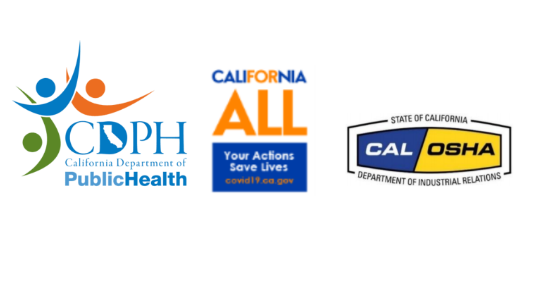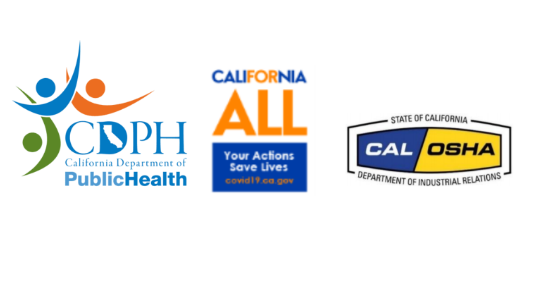Title Page
-
Conducted on
-
Prepared by
-
Location
Contents of Written Worksite Specific Plan
-
The person(s) responsible for implementing the plan.
-
A risk assessment and the measures that will be taken to prevent the spread of the virus.
-
Training and communication with employees and employee representatives on the plan.
-
A process to check for compliance and to document and correct deficiencies.
-
A process to investigate COVID-cases, alert the local health department, and identify and isolate close workplace contacts of infected employees until they are tested.
Topics for Employee Training
-
Information on COVID-19, preventing spread, and who is especially vulnerable.
-
Self-screening at home, including temperature and/or symptom checks using CDC guidelines.
-
The importance of not coming to work if employees have a frequent cough, fever, difficulty breathing, chills, muscle pain, headache, sore throat, the recent loss of taste or smell, or if they or someone they live with has been diagnosed with COVID-19.
-
When to seek medical attention.
-
The importance of hand washing.
-
The importance of physical distancing, both at work and off work time.
-
The proper use of face coverings.
-
Information on leave benefits and workers’ compensation for employees.
Individual Control Measures & Screening
-
Symptom screenings and/or temperature checks.
-
Encourage workers who are sick or exhibiting symptoms of COVID-19 to stay home.
-
Encourage frequent handwashing and use of hand sanitizer.
-
Provide disposable gloves to workers using cleaners and disinfectants if required. Consider gloves a supplement to frequent handwashing for other cleaning, tasks such as handling commonly touched items, or conducting symptom screening.
-
Strongly recommend cloth face covers.
-
Provide disposable gloves to staff handling dirty dishes and impermeable aprons and eye and face protection to dishwashers. Change and/or disinfect frequently.
-
Close or increase distance between tables/chairs in breakrooms or provide break areas in open space to ensure physical distancing.
-
Communicate frequently to customers that they should use face masks/covers.
Cleaning and Disinfecting Protocols
-
Perform thorough cleaning in high traffic areas.
-
Frequently disinfect commonly used surfaces and surfaces touched by patrons.
-
Clean touchable surfaces between shifts or between users, whichever is more frequent.
-
Equip spaces such as dining rooms, bar areas, host stands, and kitchens with proper sanitation products, including hand sanitizer and sanitizing wipes and ensure availability.
-
Ensure that sanitary facilities stay operational and stocked at all times.
-
Use products approved for use against COVID-19 on the Environmental Protection Agency (EPA)-approved list and follow product instructions and Cal/OSHA requirements.
-
Provide time for workers to implement cleaning practices during shifts and consider third-party cleaning companies.
-
Install hands-free devices if possible.
-
Consider upgrades to improve air filtration and ventilation.
-
Provide disposable or digitally available menus.
-
Provide table settings (napkins, cutlery, glassware, etc.) to customers only as needed.
-
Supply shared condiments only as needed or supply single serve containers.
-
Pre-roll utensils in napkins prior to use by customers and store in a clean container.
-
Provide takeout containers as needed and ask customers to pack their own leftovers.
-
Remove dirty linens from dining tables from dining areas in sealed bags.
-
Thoroughly clean each customer dining location after each use.
-
Provide mints, candies, snacks, and toothpicks only as needed. Do not leave out these or other items such as games.
-
Provide hand sanitizer at guest and employee entrances and contact areas.
Physical Distancing Guidelines
-
Prioritize outdoor seating and curbside pickup.
-
Provide takeout, delivery, and drive through options for customers.
-
Encourage customer reservations.
-
Ask customers to wait in their cars away from the establishment and alert them that their table is ready through their mobile phones. Avoid using “buzzers.”
-
Implement measures to physically separate workers and customers by at least six feet using measures such as reconfiguring space, installing physical partitions or visual cues (e.g., floor markings, colored tape, or signs to indicate to where workers should stand).
-
Implement the required use of face covers in working areas where physical distancing cannot be maintained.
-
Adjust in-person meetings, if they are necessary, to ensure physical distancing.
-
Stagger employee breaks, in compliance with wage and hour regulations, if needed.
-
Reconfigure, restrict, or close common areas, like employee break rooms, provide an alternative where physical distancing can be practiced, and discourage employees from congregating in high traffic areas.
-
Reconfigure kitchens to maintain physical distancing in those areas where practical and if not practical staggers shifts if possible to do work ahead of time.
-
Remove tables and chairs from dining areas, use visual cues to show they are unavailable, or install Plexiglas or other physical barriers to separate customers.
-
Close bar areas.
-
Screen guests for symptoms.
-
Limit the number of patrons at a single table.
-
Show parties to their tables one party at a time.
-
Face coverings are required for any employee who must be within six feet of customers.
-
Do not seat customers where they cannot be six feet away from employee work and food and drink preparation areas.
-
Prop open doors or automate opening if possible.
-
Post physical distancing rules.<br>
-
Implement peak period queueing procedures, including a host to remind customers to practice physical distancing.
-
Use contactless pick-up and delivery protocols to provide takeout food.
Sign Off
-
Name and Signature

















